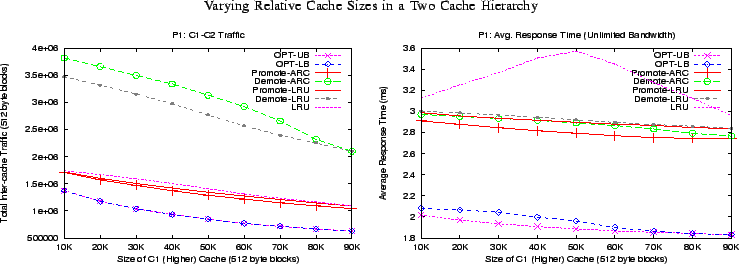



Next: Varying Inter-cache Bandwidth
Up: Results
Previous: Two Cache Hierarchy
Figure 11:
On the x-axis is the size of the  (higher) cache.
(higher) cache.
 blocks.
blocks.
 |
In Figure 11, we vary the relative size of the  and
and  caches from
caches from  to
to  while keeping the aggregate cache size equal to
while keeping the aggregate cache size equal to  blocks. We present average response time and inter-cache traffic (assuming unlimited bandwidth and free demotions) for the trace P1 (other traces have similar results). We observe that PROMOTE variants have consistently better response times than the DEMOTE variants across the entire spectrum of relative sizes. The average response time for plain LRU peaks (implying that the hit ratio is the lowest) when the two caches are of the same size. This confirms that the most duplication of data happens when the caches are of comparable sizes.
For all the other algorithms, the average response time decreases as the size of the
blocks. We present average response time and inter-cache traffic (assuming unlimited bandwidth and free demotions) for the trace P1 (other traces have similar results). We observe that PROMOTE variants have consistently better response times than the DEMOTE variants across the entire spectrum of relative sizes. The average response time for plain LRU peaks (implying that the hit ratio is the lowest) when the two caches are of the same size. This confirms that the most duplication of data happens when the caches are of comparable sizes.
For all the other algorithms, the average response time decreases as the size of the  cache increases as more hits occur at the highest cache.
cache increases as more hits occur at the highest cache.
As before, we observe that the DEMOTE variants invariably consume  x bandwidth when compared to the PROMOTE variants.
x bandwidth when compared to the PROMOTE variants.



Next: Varying Inter-cache Bandwidth
Up: Results
Previous: Two Cache Hierarchy
root
2008-01-08


![]() x bandwidth when compared to the PROMOTE variants.
x bandwidth when compared to the PROMOTE variants.